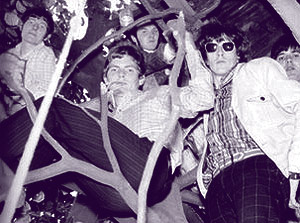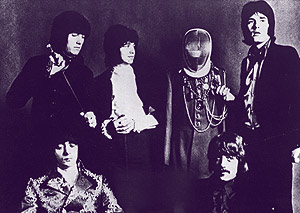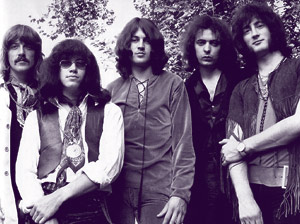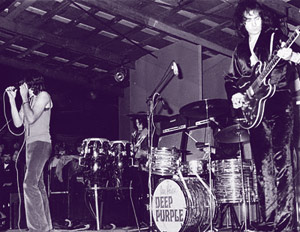Jon Lord and the classics.... Concerto For Group & Orchestra
Jon Lord's early musical training was at the piano, which he studied for many years, taking all the various grades of exam. Piano lessons being what they are, this meant learning a lot of classical music, together with the structure and theory of it. Jon kept his piano playing going at college, and when he got his first professional gig (with a band which metamorphosed intoThe Artwoods), it was as pianist. The Artwoods were simply a rhythm and blues band, a style very popular at the time. After a while though, Jon graduated to an electric organ. New to this instrument, Jon styled himself rather on contemporary players, notably Jimmy Swith. Although he was a competent player, the sound was not really very original. Realising this, Jon looked for a way to try and overcome it, and in doing so, fell back om his early training, and classical music.
  The result was twofold: The most obvious was that Jon suggested to the group that they stick some classical tunes into their act.They were all soon amazed when a chunk of Tchaikowsky, grafted on to Shake, Rattle & Roll, drew the loudest applause of the evening! It wasn't a totally unique idea; many discs of the time ripped off classical stuff; but it did suggest to Jon that a combination of the two styles might be interesting to attempt, providing it was done just for fun - like the bits
they were doing on stage. The result was twofold: The most obvious was that Jon suggested to the group that they stick some classical tunes into their act.They were all soon amazed when a chunk of Tchaikowsky, grafted on to Shake, Rattle & Roll, drew the loudest applause of the evening! It wasn't a totally unique idea; many discs of the time ripped off classical stuff; but it did suggest to Jon that a combination of the two styles might be interesting to attempt, providing it was done just for fun - like the bits
they were doing on stage.
Apart from this obvious ploy, Jon's own playing began to benefit from this study of his earlier training. He didn't start making all his solos into straight classical cops, but instead, concentrated more on the structure of classical music, and by so doing, captured the feel of it, without directly imitating it. Elements were also taken from the styles of more modern composers, such as Gershwin, and Jon's playing bacame slowly much more interesting.
Returning to the pop/classical fusion idea, there wasn't much time to experiment with The Artwoods, but two attempts nearly got off the ground, and are worth mentioning briefly. When the group began sessions for their one and only album (to be called Art Gallery), they planned to record four numbers using the New Jazz Drchestra .It wasn't the Royal Phil, but it was a start! Rather it would have been a start, for the album, when it did appear in late 1966, had none of the tracks on. The following year, Hans Bregel, a German conductor, invited the group to go over and do a concert there in December 1967 with an orchestra. However the group split up in April 1967, so nothing came of this either.
Nothing the Artwoods ever taped really illustrate either Jon's own developing style (he always plays well, but never outstandingly), nor his idea of a pop and classic get together. Three numbers he recorded soon after The Artwoods had split, in a band called Santa Barbara Machine Head, do contain some superb playing though, and hint at what he was capable of on his own.
  In late 1967 the seeds of Deep Purple were sown, and in early 1968 five musicians ended up in the studio with an album to do. Stuck for ideas, it was a case of anything goes, and Jon's experiments found room on disc at last. By now though, rocking up classics was not really new any more, with The Nice in particular having got there first. So I'm So Glad, preceded by a dash through some highights of Rimsky-Korsakov's Scheherezade didn't really break new ground, and neither did bolting an excerpt from Manuel de Falla's The Three Cornered Hat ballet score onto Hey Joe. The Book Of Taliesyn, put together under pressure from their American company repeated the same idea, and as well as We Can Work It Out getting a classical intro (a bash through bits of Beethoven and Tchaikovsky), River Deep Mountain High was prefixed by Richard Strauss' Also Sprach Zarathustra (the 2001 theme to some of us!).The only step forward was the introduction of string instruments to a number called Anthem.The result, combined with Jon's brilliant playing make for a superb track. With the eponymous third LP, taped in early 1969, this idea was taken little further, with a three part number called April. On this the middle section was written for a string quartet alone, with no attempt to combine it with the group. The idea was rather to contrast it with the group, who followed with a heavy third movement. In late 1967 the seeds of Deep Purple were sown, and in early 1968 five musicians ended up in the studio with an album to do. Stuck for ideas, it was a case of anything goes, and Jon's experiments found room on disc at last. By now though, rocking up classics was not really new any more, with The Nice in particular having got there first. So I'm So Glad, preceded by a dash through some highights of Rimsky-Korsakov's Scheherezade didn't really break new ground, and neither did bolting an excerpt from Manuel de Falla's The Three Cornered Hat ballet score onto Hey Joe. The Book Of Taliesyn, put together under pressure from their American company repeated the same idea, and as well as We Can Work It Out getting a classical intro (a bash through bits of Beethoven and Tchaikovsky), River Deep Mountain High was prefixed by Richard Strauss' Also Sprach Zarathustra (the 2001 theme to some of us!).The only step forward was the introduction of string instruments to a number called Anthem.The result, combined with Jon's brilliant playing make for a superb track. With the eponymous third LP, taped in early 1969, this idea was taken little further, with a three part number called April. On this the middle section was written for a string quartet alone, with no attempt to combine it with the group. The idea was rather to contrast it with the group, who followed with a heavy third movement.
  1969 wore on, and with it came a new line-up, Ian Gillan and Roger Glover joining in June. In the UK the band were virtually unknown. So when their outlet in the USA went bust, and their only successful market dried up, thing looked bad. The group decided on a more united direction to the music, leaning towards the rock side.They began to take any and every gig they could get, to gain a good following, aiming to follow this up with a good heavy album at the end of the year (In Rock, which was already being worked on).That would probably have been a good plan of attack, but the managment had already been looking for some way of getting the band publicity, to make sure that everyone would know who Deep Purple were when their next album arrived. In the latter days of Mk1 Jon mentioned his idea for combining a group with an orchestra. The result was that a little later, he got a phone call from their manager, who had booked the Royal Albert Hall, and the Royal Philharmonic Orchestra! He reckoned it was just the thing to get the band some much needed press space. The idea raised some doubts from the group, but Jon got to work - with three months to come up with something. The group were touring all the while, so he was under plenty of pressure. 1969 wore on, and with it came a new line-up, Ian Gillan and Roger Glover joining in June. In the UK the band were virtually unknown. So when their outlet in the USA went bust, and their only successful market dried up, thing looked bad. The group decided on a more united direction to the music, leaning towards the rock side.They began to take any and every gig they could get, to gain a good following, aiming to follow this up with a good heavy album at the end of the year (In Rock, which was already being worked on).That would probably have been a good plan of attack, but the managment had already been looking for some way of getting the band publicity, to make sure that everyone would know who Deep Purple were when their next album arrived. In the latter days of Mk1 Jon mentioned his idea for combining a group with an orchestra. The result was that a little later, he got a phone call from their manager, who had booked the Royal Albert Hall, and the Royal Philharmonic Orchestra! He reckoned it was just the thing to get the band some much needed press space. The idea raised some doubts from the group, but Jon got to work - with three months to come up with something. The group were touring all the while, so he was under plenty of pressure.
His first main concern was to find a conductor who would be sympathetic to the idea. Luckily Malcolm Arnold was willing to help. He'd written some modern classical work, so he knew the problem of acceptance for such projects. But he could also help Jon on a more practical level, that of scoring the work and showing Jon what each instrument was or wasn't capable of. Jon wrote mostly straight from his head, rather than working ideas out on the piano - something he later admitted had been rather limiting. Somehow he managed to get the piece written and scored in time.
The band turned around to find that the whole idea had escalated into a major event, and some of their doubts were realised. Because of the expense of hiring an orchestra, rehersals were limited to just a couple of run-throughs, which were, as jon put it, "disastrous!" They also found problems with their amplification, which could easily obliterate the orchestra (a new Marshall 600 watt PA mixer system, just developed, was brought in to try and overcome this). Also, they found it hard to get over the differences in the percussion department. The orchestra naturally followed their conductor, whereas a group is pushed by the drummer.The very slight difference between the two nevertheless caused a lot of problems.
The Daily Express newspaper helped to sponsor the event, along with British Lion Films - who got the rights to film the show, which was finally set for September 24th 1969.In the grand tradition, all profits (if any) were to be donated to charity, and a worthy cause was found in the Task Force outfit. .The show was to be in three parts. At first it was planned to include a performance of a Jimmy Horowitz guitar concerto, which could have been interesting if Ritchie had taken part, but this was replaced by a performance of Malcolm Arnold's sixth symphony. (Jimmy Horowitz played keyboards in the short-lived Artwoods follow-up Quiet Melon). This was followed by a short set by Deep Purple, and then the Concerto proper. Deep Purple's set shows just how nervous the group were. The solos are restrained, the playing tense, but the group were obviously out to impress, and, judging from the applause, went down very well.
The atmosphere of expectation built up during the interval, and Jon has said that he had never felt such an electric atmosphere at a concert. At the end of the Concerto the crowd gave them a standing ovation lasting fifteen minutes. Stuck for what to do as an encore, they went through the final movement once again. Happily EMI issued a recording of the evening soon after, and those who weren't there could begin to get some idea of what the performance was like from that. Me, I like the work, maybe because I'm not clever enough to spot all the classical nicks like the reviewer in The Guardian did. Obviously Jon's influences must show, but as the emphasis of the piece was to get a group and an orchestra working together, rather than write a major new classical piece, I don't really think it matters too much. One thing that did strike me at once was that the orchestra's playing wasn't all it might have been in places. Maybe it was the shame of being onstage with five long-haired hippies. Those who expected a complete fusion of a group with an orchestra were probably disappointed. Lord may have begun with that in mind, but realised that with his limited experience, and the lack of time, a compromise would be necessary. So he seems to have kept the two elements apart to begin with, the orchestra playing first, the group next etc, so that they compete rather than play together, and then gradually to bring them both together in the last movement and hope for the best. And this appears to have worked, though I do feel the orchestra got a lot more time to itself than the group did, especially in the opening movement. When the band do power in for the first time though, they show the wait was worthwhile.There seems to be a sudden release of energy that has built up from the start of the record, and they're so relieved to be doing something at last that they surge ahead almost without regard for the orchestra: But it's still more of a oompetition, and it isn't until the second movement that things even out, and the idea begins to work properly. Despite the cut in the middle of the origonal vinyl album to turn the record over, and the grotty recording of Gillan, who can barely be heard at times, it is for me the best part of the record. The orchestra is used more sparingly, complementing the group, and the result is magical at times Ironically the only thing I can criticise is Jon's own solo, which seems too long, and not very well thought out. In the final section, the group and orchestra are back at full tilt again, but there is a lot more switching between the two, and so it works better. We also get what I reckon is one of Paicey's best ever solos into the bargain. So much for my opinions.
The reviewers had a great time, though the fact that there were so many meant the evening had succeeded on one level, for here was an unknown band getting space in all the national papers: The Daily, Express said Jon had failed to unite the two factions, and had settled for a compromise. Which as I said above is probably true. It does seem though that a compromise is maybe the best one can hope for anyway, given the basic inflexibility of an orchestra compared with a group.The orchestra playing strictly from written instructions (obviously necessary with so many), the band from memory, able to alter things just by holding up a hand and signalling. Once.Jon had written the notes down, that had to be it. With more rehearsal he could have probably made changes, but there wasn't the time or the money.
Malcom Arnold seemed impressed by the evening anyway, "I have never heard before of a pop musician who could compose, and score, a work like this. Mr Lord's Concerto is witty and lively".At least he had grasped the idea of it being for fun.It was done, Jon put it, as both an experiment, and because it was an enjoyable thing to do. "We weren't trying to break down the barrier between pop and classical music.If we'd tried that the evening would have been a disaster. I thought it would come together, though be quite opposite, but still get along, which is what happened in the end. I would say that about 5% of the orchestra didn't enjoy themselves:"
English composer William Walton congratulated "The Deep Purple" afterwarde, saying "When it's done like that, it's splendid".
Jon was upset however by the many who took it all too seriously in the press, and this was the reason why he decided to take any future concerts of this sort out of the country, where the press were more open minded about modern music.
 As for all the publicity, even this wasn't all for the good, and we must look at the result of it all as far as Deep Purple were concerned. "It wasn't done for any hype reason", Jon commented. "It was an Idea I'd had five years before; but it got us labelled as a group who'd jumped on the classical / rock bandwagon. It drew attention to us at a time when we needed it, but we weren't expeced to be labelled as 'a group who plays with an orchestra'." As for all the publicity, even this wasn't all for the good, and we must look at the result of it all as far as Deep Purple were concerned. "It wasn't done for any hype reason", Jon commented. "It was an Idea I'd had five years before; but it got us labelled as a group who'd jumped on the classical / rock bandwagon. It drew attention to us at a time when we needed it, but we weren't expeced to be labelled as 'a group who plays with an orchestra'."
The result of this was the group's first internal crisis, and they'd only been together three months: "We needed something to get them to the front", said their manager Tony Edwards."I know the group basically didn't want to do it, because they felt it was too far from the rock field". To some extent these fears were realised. "It was never intended to be part of the direction of the group; it was merely an experiment. It was the turning point for us in this country, but it caused a rift in the group. What they were afraid of, and what I hadn't seen was happening, was that people weren't sure what we were all about. The group felt I was neglecting them". Poor old Jon."They got frightened that we'd get railroaded into playing hundreds of concertos.They thought I didn't want to play rook'n roll!"
This confusion amongst the public was worse as the band were unknown to begin with. If they'd been fairly well known, people would probably have seen the concerto as a one-off and nothing more. Those who did latch onto the concerto were turning up at gigs and being surprised to find no orchestra. Just to worsen the situation, the group's third album, also very unrepresentative of where they were at, was pushed out in September, to confuse folk even more. Jon tried desperately to rectify the situation in interviews, as did the others, and refuting the idea that the evening had been a gimmick. Musically I don't think it was, as Jon was trying hard to get something across; but I do wonder if it would have ever taken place had they not been in need of publicity.
One amazing incident which Jon and Ian remember well occurred in a Stoke working men's club soon after the Concerto.The owner had read all about it in the papers, and when Deep Purple arrived at the club, he apologised for not being able to book an orchestra. Not all was lost though, as he had been able to secure the services of the local brass band.
The rift in the band was also aggrevated by personal feeling though, as well as the mere problems of being a mistaken group. As Jon had written the Concerto, he was naturally the one all the papers wanted for interviews, and he rapidly became labelled as their leader. Yet in fact they had been a very democratic band from the start with Paice, Blackmore and Lord all on equal terms; and Ritchie in particular resented Lord's seeming takeover. The group even began to feel that Jon had neglected them on purpose, or that he had deliberately used them to further his own career, and would now ditch them. The tension got so bad that Jon decided to quit. Thankfully, one of the managers got them to sit down round a table and talk things out.
The result was that they agreed to make the new album an out and out rock LP, and Blackmore said if this didn't work out, he would play Concertos for ever more. He badly wanted to move into hard rock, and this decision gave him an important position within the band as regards their future direction; a position which was to become stronger as time passed and his idea was seen to work.
This.wasn't quite the end. The Concerto was done again over in America at
the Hollywood Bowl in August 1970 with tthe Los Angeles Philharmonic. "It wasn't quite so easy with them. There's a much strongest feeling over there about
rock music, and long hair, and those musicians didn't Ilike us at all" said Jon later.
The rest of the group only commented briefly on the whole affair. Ritchie "I didnt really enjoy it, but I was happy for Jon. We both like each other's stuff. He's happy now just to play with the band." Paicey: "It's too much of a heartache getting all that together for one night. You have no freedom, you just have to watch the bars".
Jon had already been approached by the BBC to write a new work. This was the original version of Gemini Suite.
Page two:
Concerto For Group & Orchestra in the DPAS online store
• Concerto For Group & Orchestra 1969 CD and SACD remix. Including Deep Purple's short pre-Concerto set.
• Concerto For Group & Orchestra
1969 DVD, VHS & DVDA
|